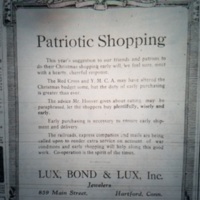Browse Exhibits (1 total)
Advertising the War: How Business Bought In.

During a convention for advertising, speaker Joseph Appel stated, "Advertising is not to sell, but to help people buy...We stand in the shoes of the customer. We are outside, not behind the counter. We are councelors for the public." The Progressive Era, the 1890's through the 1920's, saw a concerted effort to separate ad men from suppliers, and to align them with consumers. This approach had never been done before. Instead of selling a product, they were recommending them. Rather than gear ads for the company, they were made for the sophisticated reader.
Six days after the official American entry into the War to End All Wars, President Woodrow Wilson signed into existence the Committee on Public Information (CPI), also known as the Creel Committee. It consisted of mainly of Mr. Creel, and the Secretaries of State, Navy, and War who were ex-facto members. The Secretaries and had little impact, choosing to allow Mr. Creel mostly carte blanche in his Committee. In his post-war book detailing the CPI claimed that what he was doing was not propaganda. Creel stated that "In no degree was the Committee an agency of censorship, a machinery of concealment or repression. Its emphasis throughout was on the open and the positive. At no point did it seek or exercise authorities under those war laws that limited the freedom of speech and press. In all things, from first to last, without halt or change, it was a plain publicity proposition, a vast enterprise in salesmanship, the world’s greatest adventure in advertising." I will leave it up to viewer if these are propaganda items or not.
Important changes happened in the Great War, little known was how the art of propaganda (if we dare to call it that) subtly increased sales, fostered support for the war and pushed the public to sacrifice. This is a brief pictorial overview of business advertisements in local Connecticut newspapers in the Christmas Holiday season of 1917. The date range was chosen because that time of the year advertisements were more numerous and the troops were finally "Over There". The Advertising the War: How Business Bought In Exhibit will focus on involving readers and customers in the war effort, and in the background necessary to come to their own conclusions.